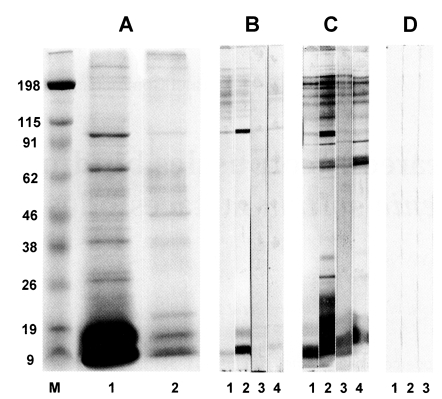Immunoblot findings of calcareous corpuscles binding proteins in cyst fluid of Taenia solium metacestodes
Article information
Abstract
After collecting calcareous corpuscles from plerocercoid of Spirometra mansoni (sparganum), we evaluated the antigenic values of calcareous corpuscles binding proteins obtained from the cyst fluid of Taenia solium metacestodes. Immunoblot analysis revealed that cysticercosis patient sera strongly recognized 10 and 95 kDa calcareous corpuscles binding proteins. This result demonstrated that calcareous corpuscles are bound with major secretory antigenic proteins, which is possibly involved in the secretory pathways of the 10 and 95 kDa proteins presenting in the cyst fluid of T. solium metacestodes.
Calcareous corpuscles, specific organelles found in Platyhelminthes, may have many biologic functions. Although several studies have been published on the formation and compositions of calcareous corpuscles (von Brand et al., 1960, 1965, 1969), their exact roles in parasites are poorly understood. Cysticercosis is a worldwide reported disease caused by the systemic spreading of Taenia solium metacestodes. A 10 kDa protein is highly specific among the several antigenic molecules when diagnosing cysticercosis by immunoblotting, in cyst fluid of T. solium metacestodes. We published in a previous study that 10, 17, 22 and 95 kDa are calcareous corpuscles binding proteins in the cyst fluid of T. solium metacestodes (Yang, 2000). In the present study, calcareous corpuscles binding proteins in the cyst fluid of T. solium metacestodes, including the 10 and 95 kDa proteins, were evaluated as to whether they react with cysticercosis patient sera.
Calcareous corpuscles of the sparganum were separated as described by Yang (2000) using Ficoll-Paque plus (Amersham Pharmacia Biotech, USA) and stored in 5 volumes of distilled water at 4℃ until required. After collecting calcareous corpuscles, 50 µg/ml of cyst fluid of T. solium metacestodes was reacted with calcareous corpuscles at 4℃ overnight. After binding with this cyst fluid of T. solium metacestodes, calcareous corpuscles binding proteins were separated by 7.5-15% SDS-PAGE and then transferred to polyvinylidene difluoride (PVDF; Millipore, Bedford, MA, USA) membranes. Membrane strips were then reacted with cysticercosis patient sera and parasite infected patients sera at a 1:100 dilution in casein buffer (0.5% casein, 20 mM Tris, 150 mM NaCl), washed with PBS/T (0.5% Tween-20). The membranes were then reacted with peroxidase conjugated antihuman IgG antibody (Fc specific; Cappel, Westchester, PA, USA) diluted 1: 2,000 in casein buffer. Colors were developed with 4- chloro-1-naphthol (Sigma, St. Louis, MO, USA).
Calcareous corpuscles were found to bind with 10, 17, 22, 35 and 95 kDa molecules in the cyst fluid of T. solium metacestodes (Fig. 1A). The bound 10 and 95kDa calcareous corpuscles binding proteins also commonly react with cysticercosis patient sera on immunoblots (Fig. 1B). Antigenic protein of 10 kDa is known to be a subunit of a 150 kDa protein in the cyst fluid of T. solium metacestodes and is a highly specific and sensitive antigen for the diagnosis of cysticercosis (Cho et al., 1988, 1992; Yang et al., 1998). This molecule has been cloned and its antigenic sites analyzed (Chung et al., 1999, 2002). The 10 kDa recombinant molecule (CyDA) was found to be reactive in 97% of active neurocysticercosis patients and showed specificity of 98% (Chung et al., 1999). Although we have not confirmed the results of the calcareous corpuscles binding experiment with the recombinant protein, we found that the calcareous corpuscles binding protein, 10 kDa, in the cyst fluid of T. solium metacestodes react with cysticercosis patient sera by immunoblotting. Another calcareous corpuscle binding protein, 95 kDa, showed a variable reaction pattern in terms of its intensity. This 95 kDa molecule cross reacts with other helminthic infection sera (Olivo et al., 1988; Yang et al., 1998). Calcareous corpuscles bound proteins including the 95 kDa protein are N-glycosidase F sensitive (complex type N-linked oligosaccharide specific) showing molecular shifts on SDS-PAGE (data not shown). This finding concord with the result of strong glycoprotein reactions in the lamellae of calcareous corpuscles in Trilocularia acanthiaevulgaris (McCullough and Fairweather, 1987). In this regard, antigenic glycoproteins in the cyst fluid of T. solium metacestodes are usually secretory proteins, and calcareous corpuscles may be involved in the secretory pathways of glycoproteins. In this paper, we demonstrated the antigenic activity of calcareous corpuscles binding proteins in the cyst fluid of T. solium metacestodes using cysticercosis patient sera. More studies are required to explain the molecular and biochemical properties of the 10 and 95 kDa calcareous corpuscles binding proteins.

7.5-15% SDS-PAGE and immunoblot analysis of calcareous corpuscles binding proteins in the cyst fluid of Taenia solium metacestodes. (A) Cyst fluid of T. solium metacestodes (lane 1), calcareous corpuscles binding proteins in the cyst fluid of T. solium metacestodes (lane 2). (B) Calcareous corpuscles binding proteins reacting with cysticercosis patient sera (lane 1-4). (C) cyst fluid of T. solium metacestodes reacting with cysticercosis patient sera (lane 1-4). Number represents individual patients, respectively. (D) Calcareous corpuscles binding proteins reacting with serum pool of sparganosis (lane 1), clonorchiasis (lane 2) and toxoplasmosis (lane 3) patients sera. Note that the 10 kDa and 95 kDa proteins showing a strong antigenicity in both calcareous corpuscles binding proteins and the cyst fluid of T. solium metacestodes. M, standard marker.